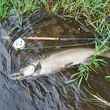As a casting instructor, I’ve been privileged to witness and analyze pretty much every kind of flycasting flaw imaginable. For a variety of reasons, those flaws most in need of correction are self-induced. But not every one. Not entirely, anyway. Though we’re all ultimately responsible for the shape of our own casting strokes, our rods can also bear some responsibility. Here’s a flaw not always of our own making: A casting stroke which is too long for the length of line being cast.
It may be hard to visualize what that means. Try this: Have you ever made a cast where your loop was wide and lazy? How about one where your line and leader failed to straighten, especially when trying to summon an extra few feet of distance? When casting into the wind, have your leader and fly ever been blown back at you? Answering yes to any of these questions means you've experienced the consequences of a casting stroke which is too long for the length of line being cast.
The rule of thumb for stroke length is this: Short line, short stroke. Longer line, longer stroke. Exactly how short or long depends on your individual physical makeup. But if you understand the clues your line provides, you’ll always know what’s right. A stroke of the correct length (along with proper acceleration) straightens your line perfectly, always with a tight loop. A stroke that’s too long—easily the most common casting fault—results in the problems mentioned above. A stroke that’s too short causes the loop to crash-land before it can straighten out.
No one I know sets out to intentionally use a stroke which is too long. So it's only natural to ask, why does it happen? There are several reasons. It can happen to beginning and intermediate casters when their strokes contain other fundamental flaws. It can happen to every level of caster when they tire. A third reason—the most insidious, by far—is because their rod encourages it.
Every cast requires a certain amount of energy. While that energy originates with the caster, the rod contributes by storing and returning to the cast a portion of the energy imparted to it. (When a rod bends, it stores energy. When it straightens, that stored energy is released.) Rods that resist bending—think of today's typical fast-action rod—require a quicker, more powerful stroke to cast.
When a fly rod taxes our strength and quickness in order to cast it, our fundamentals tend to erode quickly. Typically, our arm travels too great a distance as we try to impart the required work. We might bend our wrists too much. Often, it’s a combination of both. The net result is a stroke which is too long, with all the attendant problems that accompany it. This is an extremely common problem for saltwater-flats anglers, as they struggle to make their rods load. But freshwater fishermen experience the same thing—even with line weights as light as four and five—if their rods are overly stiff. It’s especially noticeable after a full day’s fishing.
I’m not suggesting that fast-action rods are inherently bad. Stiffness is relative. Owing to physical differences among us, a rod that's too stiff for one person might, in the hands of another, be made to work just fine. But even for the strongest of casters, some modern rods push hard the boundaries of acceptable stiffness. In my estimation, too hard. They encourage the development of casting flaws. No one needs that.
So, caveat emptor. After all, your casting stroke is a valuable asset. Train it well. Treat it well. And make sure your fly rods do the same.
































Comments
David replied on Permalink
I think you just described why I gravitate back to one of my older rods. A 4wt G Loomis built many years ago. I like describing it as relaxing to cast. I'm not an expert, but the style of the caster and the action of the rod need to match.
Great post! Thanks
Chris Korich replied on Permalink
Another great article John! Overly stiff and/or fast action fly rod designs are ABSOLUTELY contributing to students adopting inefficient casting strokes and making inconsistent casts around the globe.
Basically, when a rod is overly stiff and/or too fast in action for the weight and air resistance of the line, leader and fly, it robs ALL fly fishers of extremely beneficial FEEL, especially at the rod tip, to make consistently ACCURATE casts.
A bit of proof?
12 yr-old Maxine McCormick of the U.S. Casting Team recently outscored every women and man at the 2016 World Championships of Flycasting in Estonia, using a 40 yr-old 8.5’ full action trout rod (and so did her father and coach)!
http://www.sfgate.com/outdoors/article/S-F-s-McCormick-12-wins-world-fly...
The vast majority of other top casters competing from 15 countries? Essentially all were using modern lightweight 9' stiff, fast action fly rods!
Pages